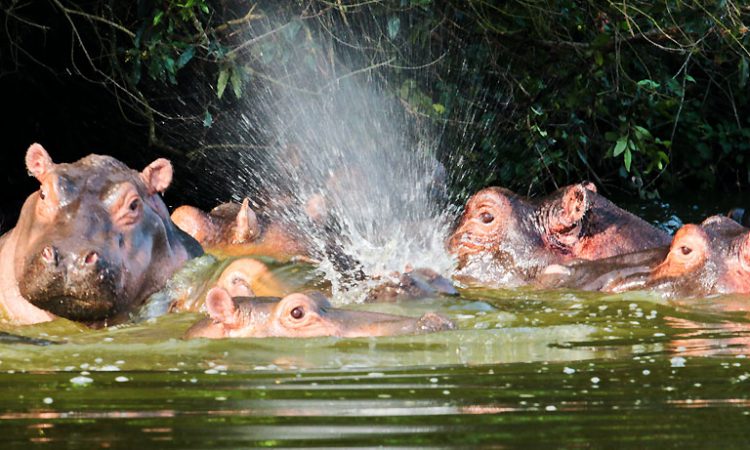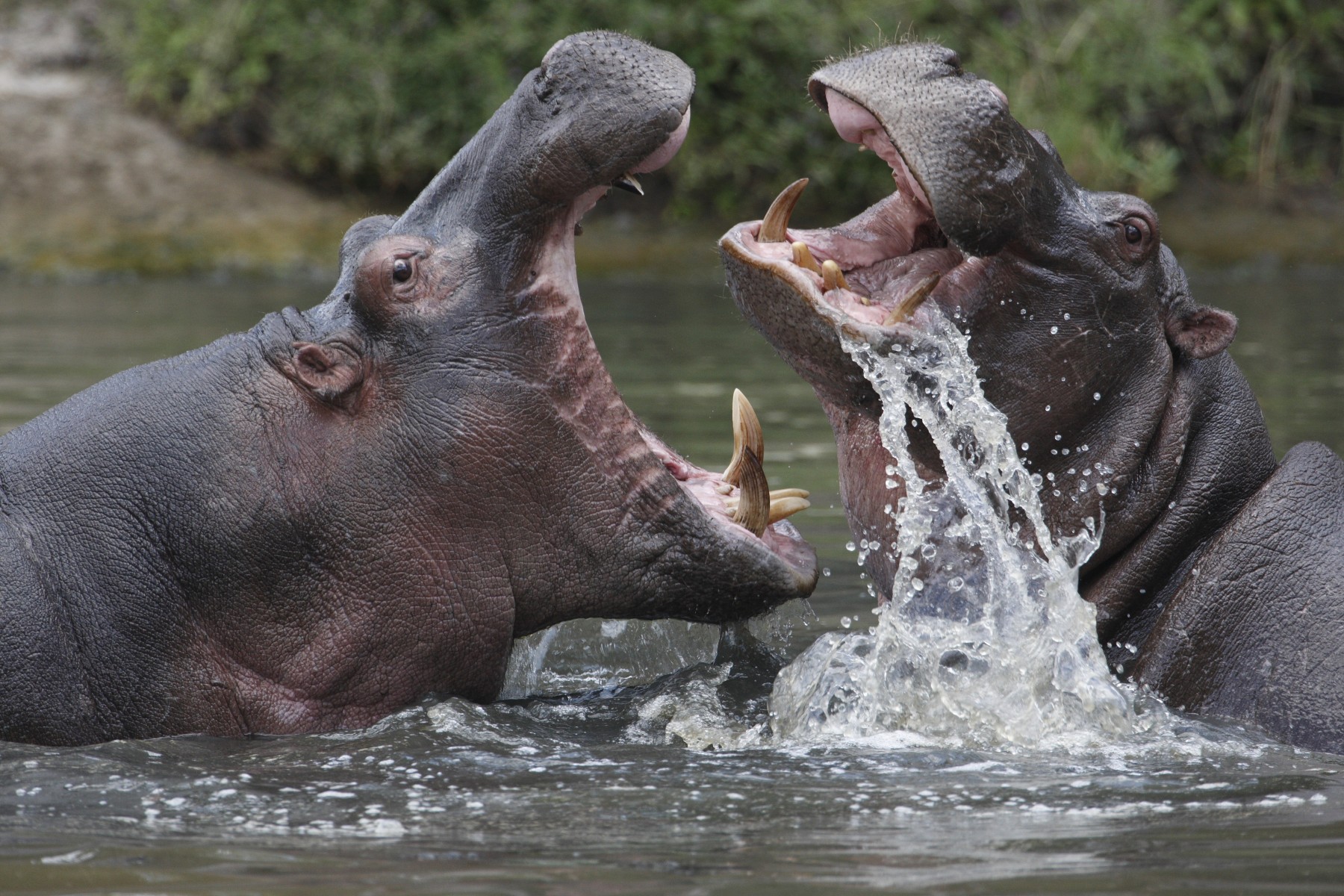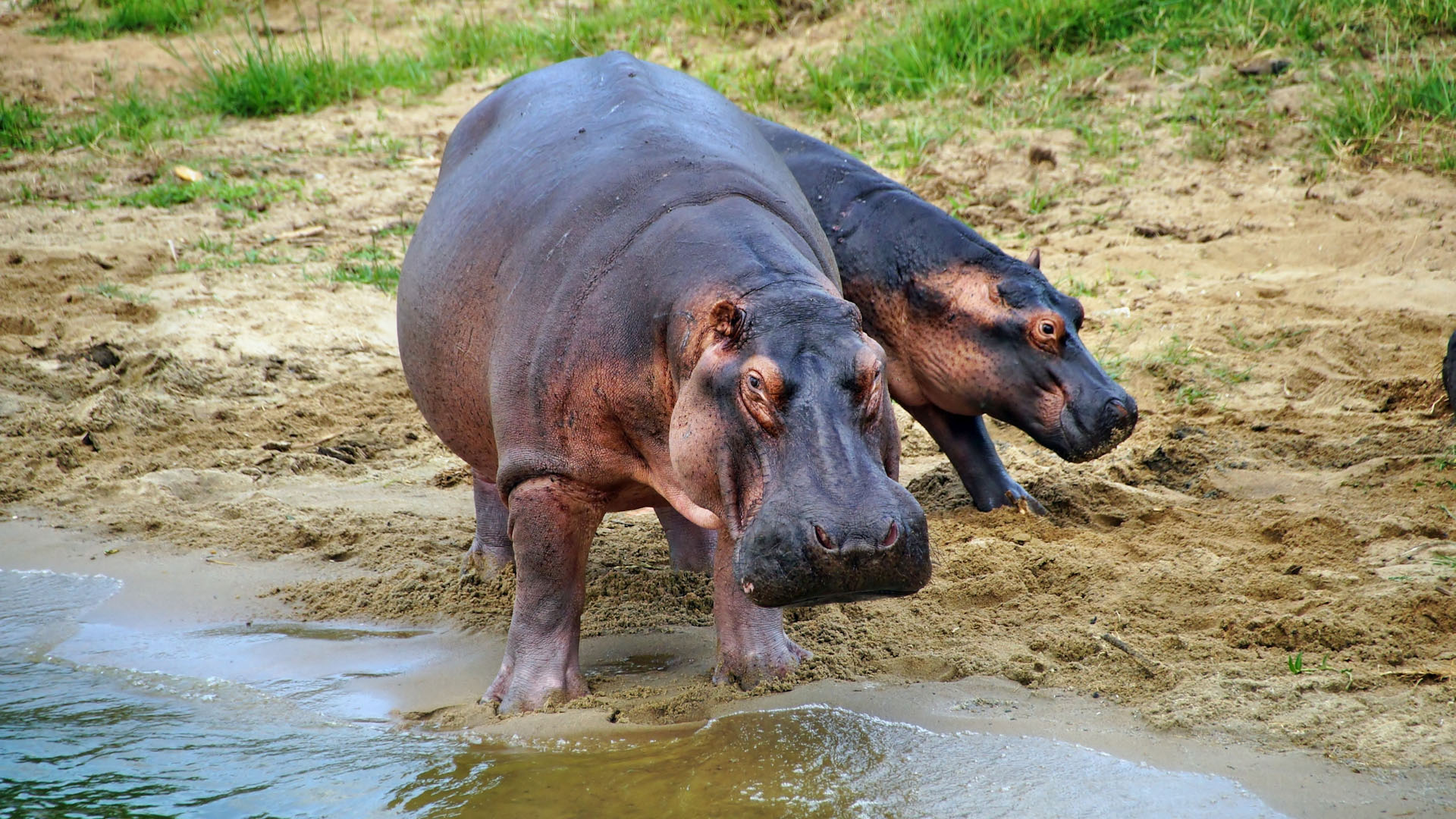12 Interesting Facts About Hippos : The hippopotamus, commonly known as the “river horse,” lives in Sub-Saharan Africa’s rivers and lakes. After the elephant, the hippo is the biggest land mammal, weighing up to 2,000kg. Hippos spend the day in the water to avoid the heat, and then come ashore at night to eat short, soft grass and fallen fruit. A hippopotamus’s eyes and ears are on top of its head, allowing it to keep an eye out for predators, primarily crocodiles, while lying low in the water. Hippos are among the beautiful animal species that tourists to Africa’s major safari parks can see on game drives or walking safaris. The following are 12 fascinating facts about hippos that you probably didn’t know and that will make your game drive on an Africa wildlife safari tour more enjoyable:

1. Hippos are giant semi-aquatic mammals with a barrel-shaped body, short legs, a short tail, and a massive head. Their skin is greyish to muddy-brown on the outside and pastel pink on the inside.
2. They are the world’s second largest land animal (the elephant is first).Males are approximately 3.5m long, 1.5m tall, and weigh up to 3,200kg.
3. To stay cool in the scorching African heat, hippos spend the majority of their days in rivers and lakes. Because their eyes, nose, and ears are on top of their heads, they can see and breathe while submerged in water. Furthermore, these amazing creatures sweat an oily red substance that protects their skin from drying out while also acting as a sunscreen.
4. Once upon a time, these majestic beasts could be found all over Sub-Saharan Africa. Unfortunately, habitat degradation and poaching have resulted in population declines. They are mostly restricted to protected regions in East African countries nowadays.

5. Hippos seek food during the night, which is when they are most active. They are herbivores, meaning they eat largely grass. They can eat up to 35 kg of their favorite food in one night.
6. Despite their massive size, hippos are excellent swimmers and can hold their breath for up to five minutes underwater. To keep water out, their ears and nose fold closed when entirely submerged.
7. Hippos normally live in herds of ten to twenty animals, each commanded by a huge, dominating male. Females, their offspring, and a few young non-breeding males make up the rest of the group, 12 Interesting Facts About Hippos .
8. Dominant men are fiercely protected by their peers. They expand their large lips and exhibit their big, curved canines to ward off competing males. They also generate violent splashes and loud moans in the water.
9. Female hippos, sometimes known as cows, have a single calf every two years. Soon after delivery, the mother and her baby band together with other cows and calves to protect themselves from predators like crocodiles, lions, and hyenas.
10. Hippos live in the wild for about 40 years. They live longer in captivity and can live to be 50 years old.
11. Their skin is extremely sensitive. If you’ve ever seen a hippo relaxing in the sun, you’ve probably seen blood pouring off their skin. There’s no need to panic; this substance is actually a built-in “Hippo Sunblock” that’s greasy and crimson in color. It not only protects them from the sun’s rays, but it’s also a great moisturizer and germ killer.
12. They are unable to breathe underwater. Hippos must resurface every 3–5 minutes to breathe, despite spending the majority of their time under water. They do it even when they’re sleeping. Hippos that are deep in their slumber will nevertheless climb to the top for a breath of air because the motion of surfacing and inhaling through their nostrils is automatic.
In conclusion, hippos can be seen in several safari parks around Africa, including Kenya, Uganda, and Tanzania. Tanzania is a great place to visit if you want to go on an African safari. The Selous Game Reserve, where vast pods of hippos lurk in the Rufiji River’s lakes, channels, and broad meanders, is one of Tanzania’s greatest spots to see hippos. Boat rides are available from all Selous campgrounds, allowing for up-close views.
Visit the Mara River in the northern Serengeti, where hippo pods snort and quarrel in the shallows, completely oblivious to the massive crocodiles. During the dry season, the less-visited Katavi National Park can be excellent for hippos, with pods of several hundred congregating in small waterholes.

Hippos can be found throughout Tanzania’s rivers and wetlands, from Lake Victoria to the swamps of Tarangire national park, the Crater Lake of Ngorongoro, and the lakes and waterholes of Lake Manyara and Katavi national parks, 12 Interesting Facts About Hippos .
Visit Uganda and Kenya for a more fun safari where you can observe hippos. Hippopotamuses can be seen on a Uganda safari in Murchison Falls, Queen Elizabeth, and Lake Mburo national park, which are rich in suitable habitats and the best places to see them on a Uganda safari. Lake Naivasha is also the best site to watch hippos in Kenya. This area is home to over 1,500 hippos, so sightings are nearly certain. Meru National Park, as well as the Maasai Mara, are also home to Kenya’s hippos.


